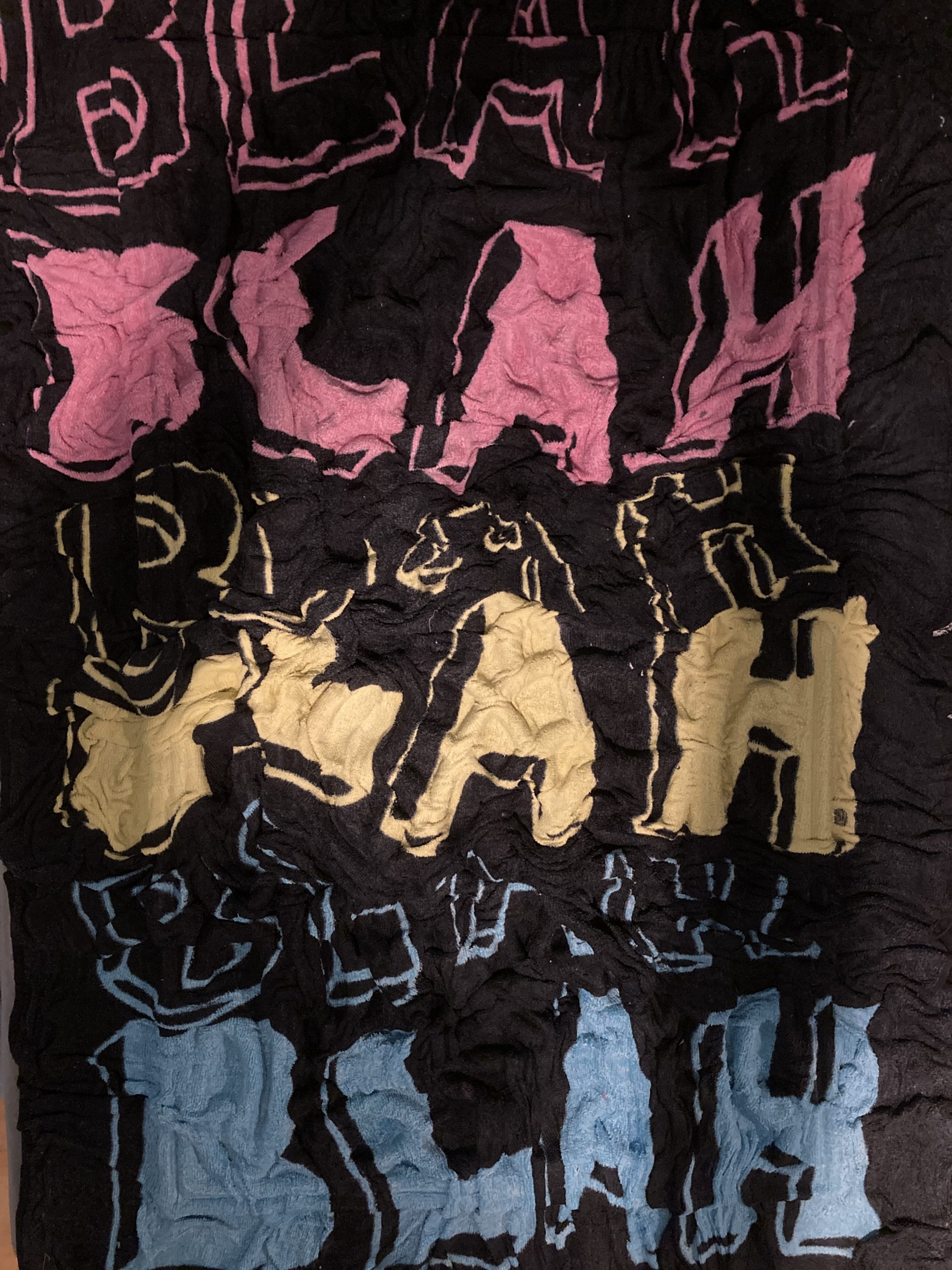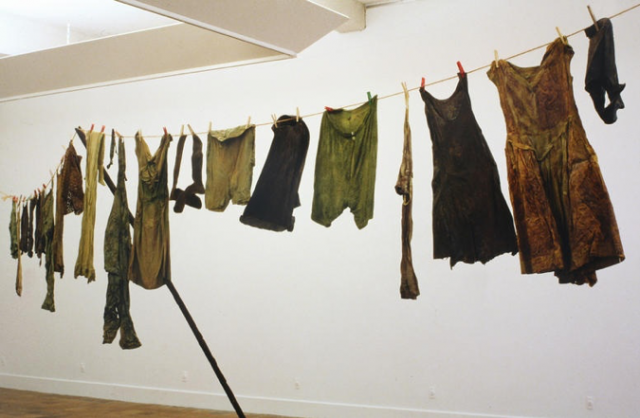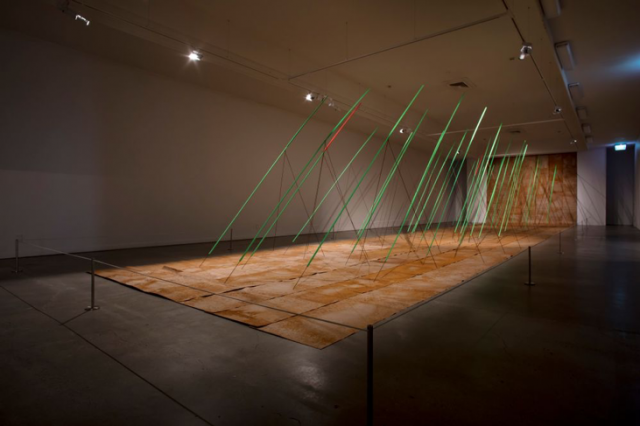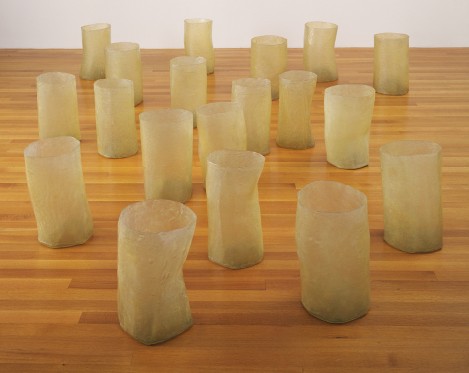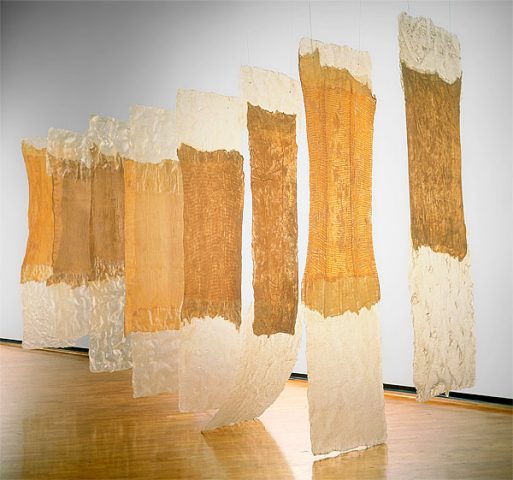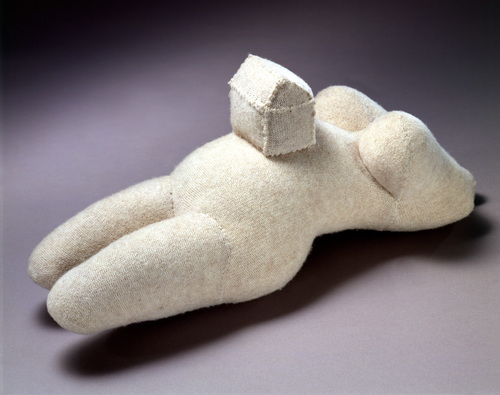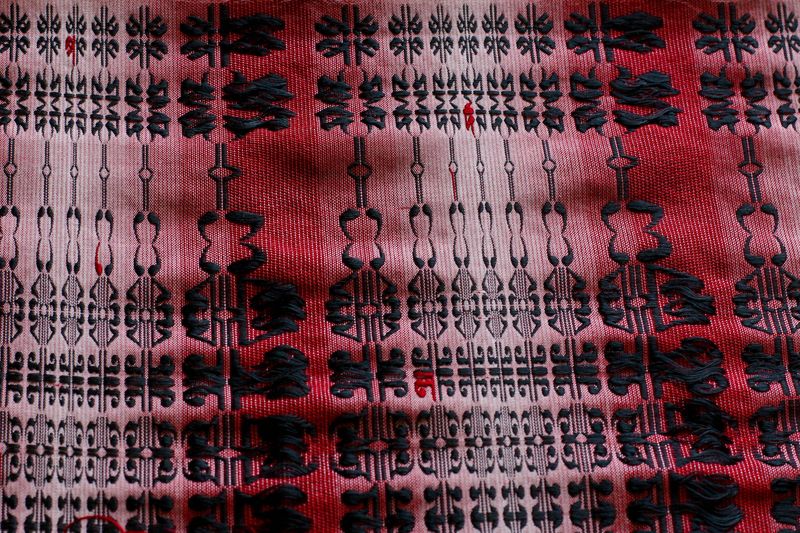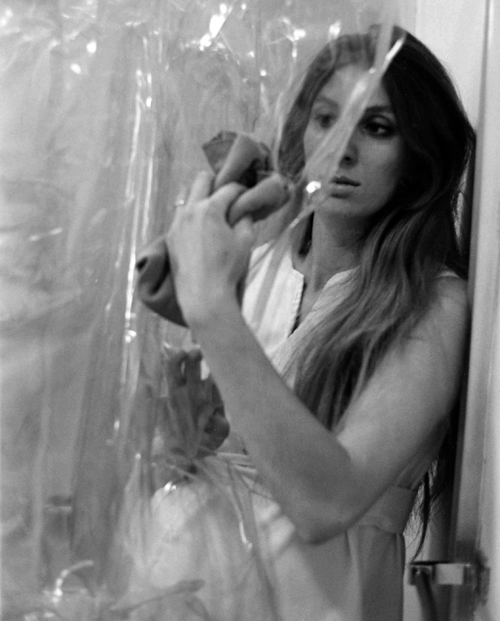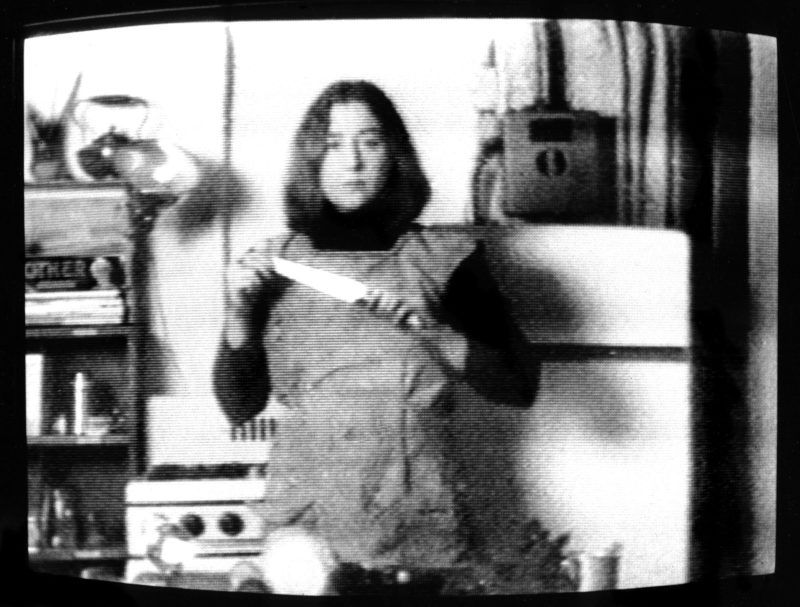This literature review sets the tone for a multi-layered practice that holds the body at the centre of a dynamic relationship with found materials and dis-used domestic textiles. The selected texts support ideas currently pertinent to my research, opening conversations regarding; an embodied practice in connection with the domestic and natural environment; hands-on, experimental material inquiry; the qualities of stitching and textile-work as method of embodied expression; the complexities of feminisms in relation to domesticity and, materiality and trace.
Embodied Knowledge
The exhibition Embodied Knowledge (7 July – 28 October, 2018) held at the Dowse Museum in Lower Hutt is significant to my practice as is the essay ‘Changing the context: Women’s art and feminism in the 1970s and 1980s’ by Wellington-based writer and curator, Priscilla Pitts. This personal account of woman artists of Aotearoa/New Zealand (NZ) and feminist discourse at the time establishes an art-historical context for my own practice as a maker. As a woman artist it is important that I am aware of historical perspectives and am able to speak to similarities and differences in my own work. Pitts’ essay includes an in-depth discussion of the artists involved in the Embodied Knowledge exhibition who draw on ideas that are important to my own work such as: lived experience of embodiment, culture, language, and environment.
Pitts says she was struck by the diversity of feminist practice evident in 1970s/80s NZ. Women artists were bringing fresh, innovative ideas into their work, challenging “what art can be and what women can do.”[1] She acknowledges the arrival of critical and intellectual feminist discussion from overseas including feminist art publications and feminist readings of art. Pitts reviews at length the controversial and critical commentary of Lita Barrie, 1986, who claimed women’s art in NZ was unsubstantial.[2] However, Barrie gave favourable mention to two artists who would later feature in the Embodied Knowledge exhibition; Taranaki-born Christine Hellyar and Cantabrian Pauline Rhodes. Barrie describes these artists as working “intuitively from their physical experience as antipodean women.”[3] In the introduction of the Embodied Knowledge catalogue, its curator Melanie Oliver encapsulates Barrie’s description within a phenomenological framework as being “informed by experiences of living in a certain time, place and context.”[4] This reference contextualises my own practice as does a mutual interest in the body as a cultural and physical entity “contingent and situated” [5] in connection with the environment.
Figure 1. Christine Hellyar, Country Clothesline, 1972 (22 latex-dipped and dyed cotton, woollen and synthetic garments, plastic pegs, Agave sisalana (sisal) rope and wooden pole, 2800 x 7200 x 900mm) Collection Govett-Brewster Art Gallery, New Plymouth.
Materiality for both Hellyar and Rhodes is an essential aspect of their art practice as it is to my own. In the seventies, working with objects and materials associated with women’s domestic labour, Hellyar was applying everyday gestures of wrapping; knotting; and sewing suggestive of an underlying feminist politics in her work. The billowing latex folds of pegged rural garments in Country Clothesline 1972, with its material reference to so called women’s work, is an example of this. Whereas Hellyar was capturing a lived experience of an everyday rural encounter,[6] I use domestic materiality to navigate my lived experiences of everyday suburbia; four decades on, touched by the fallout of a global pandemic, and environmental concern.[7]
Rhodes’ material focus pays attention to the specifics of materials, sites, and processes.[8] There are material, temporal and spatial entanglements happening in Rhodes work that I am exploring via materiality in my own practice. Her work occupies a “permeable ground” where there is a blurring of boundaries between: interior and exterior; past and present; vulnerability and stability; evident in material interplay.[9] Stained, rusted or weathered materials, exemplifying temporality, might be; propped, placed, balanced or stacked within a gallery setting, becoming a habitat in their own right. Rhodes treatment of the installation space is a continuation of a dynamic dialogue with matter and this feels so very vital to me as a maker and experiencer. Extensum/Extensor, 1982, presents green rods, used in previous ephemeral investigations,[10] cutting through space like javelins; bendy bodies puncturing a paper ground. The artefact becomes an indexical signifier of an empathic encounter.
Figure 2. Pauline Rhodes, Extensum/Extensor, 1982 (paper, wood, steel, plastic, paint) Collection of the Museum of New Zealand Te Papa Tongarewa.
Both Hellyar and Rhodes draw from experiences of the body; fertile, regenerative, active and vulnerable, in relationship with the natural world. Working methods of repetition and process, common to both artists have been linked to the “eternal reoccurrences” of nature, and these relate to the feminine and maternal,[11] ideas that I nurture in my own practice. Hellyar explored, and continues to explore, material connections between the generative human body and the body of the land. Rhodes’ experience of the body was through physical and sensorial connection where the female attributes of endurance and perseverance were explored through running. By sensing what was underfoot her concern was “to feel as fully as possible the actuality of her body”,[12] a sensation I identify with as I walk with long open strides across the dermis of the land.
Rhodes talks about “the sensuous flow of matter”[13] derived from bodily, sensory interactions in synch with the environment. In this regard, her work has more recently been read in relation to eco-feminist Donna Haraway, in the way that people are part of their surroundings not separate to them.[14] This aligns with my own world view that acknowledges: a vital interdependency of all living things; a strong association between women and nature that is inherently inter-connected; value for the richness of diversity amongst all matter (human and non-human) and the essential contribution of an intuitive practice. In this vein, embodied knowledge as identified in this catalogue and in the work of Hellyar and Rhodes, is knowledge that is indeed spoken[15] — internally and externally via a deep felt-sense.[16] I draw and extend on this sensorial, felt, embodied knowledge, and tap into the histories and wisdoms of these, and other women practitioners, and their essential interactions.
Practice and Material Process of Eva Hesse
Post-minimalist Artist Eva Hesse (1936-1970), located a way to communicate with, and in the world around her — the absurd in life and in art had a safe place to play. There are many relevant and thought-provoking ideas in Hesse’s approach and practice that are relevant to my own. These ideas include the use of everyday, readily available materials; sensorial and bodily relationships with matter; and absurdity as methodology. I have chosen the article: To Conjure Hesse, by Eve Meltzer as it discusses ideas of material relationship and artistic experience, which further contextualise my practice.
Working with casually found, or everyday available materials, Hesse invited a child-like sense of discovery to inform spontaneous material innovation, an approach that I foster in my own practice. While Hesse was drawn to use discarded material collected from various neighbourhoods,[17] my own collection is typically sourced from within the home or in close proximity. Alongside matter that can be held in the hand, writing and language are vital material contributors to my practice and evidently to Eva Hesse. She used diary entries to externalise emotions, to make connections with inner and outer worlds — freeing and feeding these findings into material explorations and installation strategies, we both utilise/d stream of consciousness writing and metaphoric language to edge closer to an embodied knowing of feelings and ideas.[18] Hesse also utilised new technologies, readily available to artists of this era, testing the limitations of latex, fibreglass and resin.[19] My own scientific processes are equally enthusiastic, although less dramatic and much less toxic, using textiles in relationship with: various adhesives; natural dyes and oxidising agents typically found in domestic environments such as school glue, sugar-water solutions, tea and vegetable stains as well as elements of air and water. In Hesse’s practice and my own, it is vital to remain open to the expressive potential of matter, and to be responsive to an accumulation of findings within an art process, rather than fixed to a single determining idea.
A visceral, sensorial relationship with the malleable properties of materials was apparent in Hesse’s process, and this often extended into repetitive, serial investigations. It was important for Hesse as it is for me to acknowledge touch, via the artist’s hand in making. Gestures of touch were performed such as; wrapping, hanging, pouring, attaching, coiling and shaping. These gestures offer material trace of the maker’s touch that would then continue to exist in the artefact in the absence of the body.[20]
Figure 3: Eva Hesse, Repetition Nineteen III, 1968, 1968. Fiberglass and polyester resin, nineteen units, Each 19 to 20 1/4″ (48 to 51 cm) x 11 to 12 3/4″ (27.8 to 32.2 cm) in diameter. From the Collection: 1960–1969. The Museum of Modern Art.
Hesse offered intensely handmade pieces, such as the intimately crafted cylindric bodies of Repetition Nineteen III, 1968. Beholding Hesse’s work is a whole body experience requiring a sense of openness to engage with the “materialities we encounter”,[21] as experiencers of art. “She’s making a situation in which I can feel something,” says artist Mary Weatherford.[22] Art historian Alex Potts describes a messiness that is human-like, echoing what he imagines his insides to look like. Artworks such as Untitled 1970 (Rope Piece), hang heavy in space “borne downward toward the earth”.[23]Hesse’s latex findings; lean, dangle, almost chewy in their skin or umbilical-like, tactile states — there is a temptation to touch which I enjoy, and there are visual and visceral associations that invite further meaning making. This evocation of feeling as beholder is an area of intrigue in my own work, where experiencing the artefact becomes a curious bodily exchange.
Figure: 4 Eva Hesse, Contingent 1969, cheesecloth, latex, fibreglass, installation (variable) 350.0 (h) x 630.0 (w) x 109.0 (d) cm. Purchased 1973. NGA 1974.395. Courtesy The Estate of Eva Hesse, Galerie Hauser & Wirth, Zurich.
Deep in process, Hesse’s material-based sensibility would push an idea until, “a level of absurdity or extreme feeling came through,” or when the materials ran dry.[24] I relate to this intense material relationship while making, where a moment-of-rightness arrives as a felt-sense — at the end of a succession of vigorous processes. Hesse also used this idea of so called absurdity, to make installation decisions relating to the accessible edge; of wall, floor, ceiling, artefact and beholder. Whereas Hesse used the term absurdity to explain her often extreme or unusual material enactments I toy with absurdity as methodology; experimental; forgiving; open-ended, and this helps me to stay in the flow of making, to be with the feeling of the work and to reach around any aesthetically anticipated endpoint.
Hesse was a knowledge seeker working from a place of “not-yet-knowing”[25] a description that I resonate with in my own practice where insight and mastery is always emerging. Nestled within the ambiguous boundaries of the absurd, Hesse’s practice was a deeply immersive, physical making experience, a navigation of intense yet sensitive material relationship. “It is what is yet not known, thought, seen, touched,” says Hesse in the accompanying catalogue for Contingent 1969, months before her death.[26] When I think about the practice of Eva Hesse I am typically immersed in the soulful hands-on aspects of art-making, pushing beyond what I know, in awe of the magic of materiality unfolding before me.
Thread, Stitching and Embroidery
In Stitches BBC Radio 4 documentary, 2018
I wanted to include a text that observed the sensory qualities and complexities of working with thread and textiles; haptic sensations that lure me to this material resource in my own art practice, via domestic textiles and found thread. Alongside this I wanted to reference feminist concepts in relation to textile and embroidery work, including examples of artists using thread-work and textiles in radical ways. I found such discourse in a 2018, Radio Documentary, called In Stitches, where selected artists and educators share their relationship with embroidery, textiles and making; offering a generosity of spirit and communitas, which I felt very appropriate in the context of this research.[27]
In the folds of cloth there is a sense of familiarity and safety, malleability, connection and also tension, rupture and loss. When I stitch in my practice, I drop into embodied memory, of sewing with my mum and her mum; tenderly darning socks as if mending the soles of our feet. Textiles researcher and artist, Dr Claire Pajaczkowska, talks about a practice of “textile thinking and tacit knowledge”; an embodied relationship with materials, characteristic of making where head, hand, heart and textile operate as one.[28] “Embroidery makes sense to me, it’s in my blood”, says artist and embroiderer Hannah Hill.[29] There is a heritage of thread and textile work in women’s hands, a visceral, unspoken connection with the physical, tactile nature of this material resource.
Embroiderer Richard McVetis refers to an energy and tension in the audible intersection of fibre with fabric, and an obsessive relationship with the repetition involved in stitching.[30] Social anthropologist Tim Ingold describes this kind of receptive and responsive interaction; between the mindful bodily movements of the maker and the flow and resistance of the material, as a “dance of animacy”.[31] This idea resonates with my own physical negotiation with soft and hard materials, where I engage in a kind of moving meditation with materials of interest, to ignite feeling and familiarity, and this extends into repetitive and ritualised making. This hands-on process of working with textiles and stitching especially, implicates the physical material body in its repetitive, performative action that extends from the body in rhythmic, intense connection.[32]
The culture of textiles and embroidery touches on the quiet strength of the feminine, and this should not be mistaken as “useless vulnerability”.[33] Fostered as part of a woman’s domestic tutelage in the Victorian era; “a marker for refined femininity”, embroidery has transformed a primal activity of repetitive movement, into a thoughtful human action; to mend; to cover; to protect, like making a “second skin.”[34] This idea illuminates connections between textile work, family and motherhood that are important aspects of my practice.
Figure: 5 Louise Bourgeois. Femme Maison 2005. Fabric.
Artist Louise Bourgeois (1911–2010), worked intensely with the interrelationship of textiles, women, the home and the body. She transformed cast-off fabric and preowned clothing; positioning, stitching, shaping, hanging or draping these textiles as an evocation of women.[35] Her sculptural installations utilised a tactile and sensory colour palette, red being significant of painful personal memories, red with blood and blood with pain. She often applied unwieldy stitches to textile-based sculptures, or tucked stitches neatly away, her needle a tool for repair, revealing and re-storying unhelpful childhood experiences through this enactment. Co-opting dis-used textiles is a pivotal aspect of my own practice and like Bourgeois there is an element of repair in my relationship with the needle and thread. There is also a physical connection in the enduring bodily action of my arm, in perpetual extension and contraction. The motion of stitching like inhalations and exhalations of air, strengthen and revive the malleable body of the dis-used textile.
Staying with this idea of perpetual movement of unfurling and folding in a continual process of becoming, I think about French Philosopher Gilles Deleuze’s (1925-1995) discussion of the fold, which is a complex take on the compression of time and the folding in of dimensions and spaces.[36] In my practice I utilise the bodily associations of the tangible fold as in; folds of the skin, the folding brain, organs, and collapsing body parts. I’m dealing with soft material as “neither object or subject”, but as the threshold between, and in this liminal space there is a sort of composting of meaning into materiality.[37] The action of tearing or stitching disrupts the fold and invites new meaning.
Figure: 6 Raiser Kabir, Lift the veil and see our silent language. 2013. Detail. From https://lids-sewn-shut.typepad.com
Alongside the softer, nurturing aspects of this craft, women have used the medium throughout history as a voice for the marginalised.[38] Contemporary textile and performance artist Raiser Kabir says “politics and textiles are intertwined”.[39] Kabir uses thread and textiles to express notions and emotions of family, imagined ancestry and othered cultures. She believes in the power of documenting your own family’s story, such as in Lift the veil and see our silent language(2013). This multi-sensory experience of stitched and spoken Bengali, invites the experiencer to get up-close, to follow the threads, to be curious, and to make their own associations with the tactile material. These are the kind of responses that I aim to evoke when presenting my own work, whereas Kabir is often physically present in her work through performance, the performativity of my pieces lie in their materiality, their interrelationships within the installation space and connection with the beholder.
Materiality, philosophy, family, nature and feminisms intertwine; I embody the culture and language of embroidery and stitching. I think of the humble needle, its power of construction and transformation — 17 thousand years old. I draw from a lineage of makers and menders; cradling the fold, I feed the thread “like a symbolic umbilicus”.[40]
Reading the Strange Case of Woman-as-Appliance
The domestic space: the house, the home, the site where women over the course of time have been observed and criticised in what they do. A core aspect of my practice is drawn from my lived experience of domesticity in Tāmaki Makaurau; from the front gate to the creek that marks the rear boundary line, and everything in between. Recent COVID-19 pandemic response strategies in this country, requiring enforced time at home, have amplified my relationship with domestic life. Everyday realities of womanhood, motherhood, housekeeping, partnership and career, have infiltrated my art practice and drawn my attention to the lively matter in my immediate surroundings. When I came across Reading the Strange Case of Woman-as-Appliance by August Jordan Davis,[41] the article captured the material entanglement of all that was being stuffed into this home-space, for me at this time.
In my practice I consider my body, alongside domestic materiality, as dynamic substance interconnected via the sensory act of touch and other performative gestures. The idea of a “fabricated hybrid of machine and organism,”[42] assembled from interactions with domestic objects that surround me in my daily life is potent and compelling. Woman-as-Appliance (W-a-A), makes me think about Donna Haraway’s making kin, in an interspecies, beyond-human kind of way.[43] New materialism theorist Jane Bennett describes a “vital materiality that runs through and across bodies, human and nonhuman,”[44] her discussion on “thing power”,[45] positions everyday objects as innately animate, already potent with agentic capacities of varying degrees. This makes me think about artist Pauline Rhodes Intensum / Extensum projects which explore the “thingness of the world,” and this includes the body as thing as it moves dynamically through space and time.[45b] Bennett references philosopher Henry Thoreau (1817-1862) who said, a “trained gaze, prompted by the experience of [one’s] own body, will discover in all other ‘objects’ the miracle of expression.”[46] This is my approach to art-making in my practice, where my body agitates agential forces through curious engagement with matter. This is enacted through performative gestures such as: stretching, twisting, hanging, tearing; and teasing apart, and this situates the body of the artist in dynamic partnership with the vibrant matter at hand.
Figure 7: Mierle Laderman Ukeles, Dusting an Artwork from: Private Performances of Personal Maintenance as Art, 1970–3, black and white photograph. From https://www.frieze.com
The figure of W-a-A is oriented to the interior, operating strictly within the boundaries of the home, [47] her potential only truly realised in the execution of domestic activities.[48] This makes me think about maintenance artist Mierle Laderman-Ukeles (b.1939), who challenged social and cultural perceptions on so called women’s work by performing domestic activities as part of her enduring Manifesto for Maintenance Art 1969!. Converting everyday tasks into performance and art, she raised the profile of maintenance in both public and private spaces, across genders and socioeconomic standing.[49] Whereas Ukeles art was often the performance of maintenance in public spaces, I work with ideas of body maintenance; working metaphorically with found objects and fabric to perform a blend of maintenance and care, exploring vulnerable aspects of the body’s interior and exterior. The enactment of intimate maintenance rituals with dis-used textiles such as; washing; drying; and folding, are important material-based preparation strategies in my practice.
Figure: 8. Martha Rosler – Semiotics of the Kitchen, 1975, video still.
Video (black and white, sound). 6:09 min. © 2021 Martha Rosler. Courtesy Electronic Arts Intermix (EAI), New York.
When W-a-A is in control of her domestic settings, she can utilise them to extend her own human capacity. Davis uses artist Martha Rosler’s (b. 1943), The Semiotics of the Kitchen, to illustrate the “malfunctioning” housewife who uses the “tools of her own inscription to counter-perform her own eventual emancipation.”[50] I like the use of the word malfunctioning in this context as it enlists the very human trait of resistance, which can lead to meaningful change, resistance also being a material quality that I am drawn to use in my practice. Whereas Rosler’s performed video work uses domestic props and gestures to enact ideas, I am using domestic materiality to perform an extension of bodily capacities such as; wrapping as bandages, and applying fabric as prostheses. I perceive the home as a physical extension of the material body rather than a restrictive machine for living with its: openings; ecosystems; drainage and circulation networks. I co-opt found objects from around my home to help articulate these ideas of expansion.
[1] Pitts, “Changing the context: Women’s art and feminism in the 1970s and 1980s,” 30.
[2] Pitts, (Via the National Criticism Symposium, NZ.), 23.
[3] Barrie in Pitts, 23.
[4] Oliver, “Two Limbs: An Introduction to Embodied Knowledge/Can Tame Anything,” 9.
[5] Oliver, 9.
[6] Hanfling, “Four Decades on, an Interview with Christine Hellyar,” 30.
[7] Referring to the lockdowns in Auckland, NZ that began in March 2020, in response to COVID-19.
[8] Barton, “Ground/Work: The Art of Pauline Rhodes”, 14.
[9] Barton, 38.
[10] Pitts, (Rhodes ephemeral investigations often placed foreign objects into the environment, recording trace of “unmediated human presence” on the landscape. 27.
[11] Barton, (referring to Julia Kristeva’s book “Women’s time”, 1979.), 26.
[12] Green, “Placing the Art of Pauline Rhodes,” 27.
[13] Barton, (This refers to Rhodes artist page, created in response to her “daily runs”, which alludes to the voice of material bodies in motion; human and of the environment.), 23.
[14] Huddleston, “Always Coming Home”, in Abby Cunnane and Charlotte Huddleston (eds.), Dark Watch, ST PAUL St Gallery: Auckland, 2016, 15.
[15] Pitts. (As I conclude, I’m urged to circle back to Oliver’s introductory catalogue description of embodied knowledge, where she begins by saying it is “knowledge that is unspoken …”. I am curious about this, believing that embodiment is indeed spoken). 9
[16] Klein, Julian “What is Artistic Research?”. German researcher and theorist Julian Klein says embodied knowledge is “artistic knowledge” that is “sensual and physical” whether “silent or verbal”, and this seems evident in the practice of the artists discussed.), 6.
[17] Meltzer, “To Conjure Hesse” (From discontinued mechanical parts sourced by Hesse while sharing a factory/studio in Germany 1964, to dealing with debased waste materials from local Canal Street on her return to New York in 1965 – Hesse worked with an object’s properties in new and interesting ways.) 74.
[18] Meltzer, (Daily diary entries described feelings of vulnerability and instability, and these fed into material explorations of fragility and tension often using gravity as an agent.) 76.
[19] Meltzer, Hesse questioned the limitations of new technologies using readily available latex, fibreglass and resin, resulting in works such as Aught, Augment, and Seam all from 1968.) 76.
[20] Pajaczkowska, “On Stuff and Nonsense: The Complexity of Cloth”, (“We intuit the significance of wrapping as a prosthesis of touch.”) 223.
[21] Jones, “Material Traces”, 27.
[22] Mary Weatherford in Paul Getty Trust. “Eva Hesse: Oh, More Absurdity”, 2019. Retrieved from https://www.getty.edu/recordingartists/season-1/hesse/
[23] Stevens, Mark. “Fear of Flaying.” New Republic 208, 1993. (4): 29–32, 30.
[24] Nesmer, “An Interview with Eva Hesse”, para 6.
[25] Klein, (German researcher and theorist Julian Klein, suggests research means not-yet-knowing, and the desire for knowledge), 1.
[26] Kraus, Bachelor, 92. (One of Hesse’s final exhibition pieces before her death, Contingent 1969, is described by Art critic Rosiland Krauss as embodying the expressive power of matter in and of itself. “In art-historical terms we could say that Contingent was countering the formalist dialogue of the 1960s with the message of expressionism”. The physical work that hangs arguably as hybrid, neither painting or sculpture presenting as 8 flesh-like latex and fibreglass panels, suspended at various heights from the ceiling. In the accompanying statement, Hesse speaks of material strategy, and nuanced personal response — intertwined).
[27] “In Stitches” explores contemporary radical embroidery, and aired on BBC Radio 4 at 11.30am on 15th November, 2018. Presented by Amber Butchart, it’s A Curtains For Radio production produced by Louise Morris and Andrew McGibbon for BBC Radio 4.
[28] Pajaczkowska, “The Thread and the Line”, 20.
[29] “In Stitches”, (Embroidery artist Hannah Hill, noting her ancestral connection to India and its history of service embroidery).
[30] “In Stitches”.
[31] Ingold, Making: Anthropology, archaeology, art, and architecture, 101.
[32] Pajaczkowska, “On Stuff and Nonsense: The Complexity of Cloth”, 223.
[33] Parker, “The Subversive Stitch”, (Kate Walker), 211
34 Pajaczkowska, “On Stuff and Nonsense”, 235.
[35] Parker, “The Subversive Stitch”, xviii
37 Deleuze, Gilles, The Fold: Leibniz and the Baroque. Minneapolis: University of Minnesota Press, 1993.
[37] Pajaczkowska, “On Stuff and Nonsense”, 220.
[38] “In Stiches”, (Referring to Victorian England. The time spent in action and effort that gives the medium its power as a political tool. Mary Queen of Scots utilised embroidered universal symbols to convey hidden messages, while under house arrest in mid 16th Century; handsewn banners were used by women in the suffragettes to deliver political statements; feminists of the seventies used embroidery as a tool to protest against women as domestic chattel).
[39] “in Stitches” (Kabir and Hannah Hill raise cultural, social and gender issues associated to the histories of textile making, still salient in Europe from the Victorian era).
[40] Pajaczkowska, “The Thread and the Line”, 19.
[41] Davis, August Jordan. “Reading the Strange Case of Woman-as-Appliance” (Woman-as-Appliance offers a satirical yet deadly serious feminist critique of a woman’s place in post-World War II America, when women were challenging their relationship with domestic labour and the social constructs that bound them to the home).
[42] Haraway, “A Cyborg Manifesto”, 150.
[43] Haraway, Staying With The Trouble.
[44] Bennett, Jane. Vibrant Matter, preface. (Bennett pursues a materialism in the tradition of Democritus-Epicurus-Spinoza Diderot-Deleuze).
[45] Bennett, 1.
[45b] Barton, Ground Work, 124.
[46] Bennett, 5. (Thoreau, Writings, III (Thoreau trained his gaze on things with the faith that “the perception of surfaces would always have the effect of miracle to a sane sense” [Thoreau, Journal, 2: 313]).
[47] Davis, (The author explores “the co-ordinates of the domestic space”. The kitchen, arguably the heart of the home, loaded with appliances and clean productive surfaces are humanised by Rosler’s flesh-facing photomontages from the ‘Body Beautiful, or Beauty Knows No Pain’, series, c 1966–1972. Rosler collaged female body parts onto what Davis refers to as the “skin of domestic appliances”. Situating the image of a woman alongside cuts of meat, introduced the male gaze and the idea of woman as “object for consumption”. Moving to the sleeping quarters, Rosler’s 1988 video work Baby $M, 1988, presents Woman-as-Appliance as an incubator or baby factory in “the industrialisation of motherhood”.)
[48] As proposed by Simone de Beauvoir in her book The Second Sex, 1949.
[49] Phillips, Patricia C., et al. Mierle Laderman Ukeles: Maintenance Art.
[50] Davis, (Martha Rosler’s The Semiotics of the Kitchen), 375.
Bibliography
Barad, Karen. Meeting the Universe Halfway: Quantum Physics and the Entanglement of Matter and Meaning, 2007. Durham: Duke University Press.
Barton, Christina. Ground/Work: The Art of Pauline Rhodes, Adam Art Gallery and Victoria University Press: Wellington, 2002.
Bennett, Jane. Vibrant Matter: A Political Ecology of Things. Durham: Duke University Press, 2010.
Berndtson, Arthur. “Beauty, Embodiment, and Art.” Philosophy and Phenomenological Research 21, no. 1 (1960): 50-61. doi:10.2307/2104788.
Bocancea, Emanuela. “Material Matters: ‘Intramateriality’, ‘Intermateriality’, and Neolithic Figurines” Architecture, Body, and Performance in the Ancient Eastern World, Joukowsky Institute for Archaeology & the Ancient World, Brown University, Retrieved from https://www.brown.edu/Departments/Joukowsky_Institute/courses/archbodyperform10/10148.html
Coole, Diana. “Rethinking Agency: A Phenomenological Approach to Embodiment and Agentic Capacities”, Political Studies: 2005 VOL 53, 124–142. Birkbeck College, London.
Danto, Arthur C. “All About Eva.” Nation 283, no. 3 (July 17, 2006): 30–34.
Davis, August Jordan. “Reading the Strange Case of Woman-as-Appliance” Third Text 29, no. 4/5 (July 2015): 356–76. doi:10.1080/09528822.2016.1152091.
Deleuze, Gilles, The Fold: Leibniz and the Baroque. Minneapolis: University of Minnesota Press, 1993.
Finch College Museum of Art, Hesse catalogue statement, for Contingent. Retrieved from https://nga.gov.au/international/catalogue/detail.cfm?IRN=49353
Frascina, Francis. “Unhomely.” Art Monthly, no. 438 (July 2020): 6–9. Retrieved from https://search.ebscohost.com/login.aspx?direct=true&AuthType=url&db=vth&AN=144349023&site=ehost-live.
Green, Tony. “Placing the Art of Pauline Rhodes”, Art New Zealand Winter 2003 issue 107.
Hanfling Edward. “Four Decades on, an Interview with Christine Hellyar”, Art New Zealand Winter 2012 issue 142, 30-37.
Haraway, Donna J. “A Cyborg Manifesto: Science, Technology, and Socialist-Feminism in the Late Twentieth Century,” in Simians, Cyborgs and Women: The Reinvention of Nature (New York; Routledge, 1991), pp.149-181.
Haraway, Donna J. Staying with the Trouble. Duke University Press, 2016.
Huddleston, Charlotte “Always Coming Home”, in Abby Cunnane and Charlotte Huddleston (eds.), Dark Watch, ST PAUL St Gallery: Auckland, 2016, p. 15.
Ingold, T. Making: Anthropology, archaeology, art, and architecture. Oxon, England: Routledge, (2013).
Jones, Amelia. “Material Traces: Performativity, Artistic “Work,” and New Concepts of Agency.” TDR: The Drama Review59, no. 4 (2015): 18-35. muse.jhu.edu/article/602877
Klein, Julian “What is Artistic Research?”, Research Catalogue (2012) https://www.researchcatalogue.net/view/15292/15293/0/0 [accessed 03/03/2021]
Kraus, Rosalind. Bachelor. October Books. 1999
Meltzer, Eve. “To Conjure Hesse.” Art Journal 75, no. 3 (Fall 2016): 73–76, 73.
Moss, Karen. Moss, Karen, “Martha Rosler’s Photomontages and Garage Sales: Private and Public, Discursive and Dialogical”, Feminist Studies 39, no. 3, 2013: 686-721.
Miles, K. “Ecofeminism.” Encyclopedia Britannica, October 9, 2018. https://www.britannica.com/topic/ecofeminism.
Nesmer, Cindy. “An Interview with Eva Hesse” Artforum, May 1970. Retrieved from https://www.artforum.com/print/197005/an-interview-with-eva-hesse-36407
Nemser, Cindy. “My Memories of Eva Hesse.” Woman’s Art Journal 28, no. 1 (Spring/Summer 2007): 26–28.
Oliver, Melanie. “Two Limbs: An Introduction to Embodied Knowledge/Can Tame Anything,” Embodied Knowledge / Can Tame Anything, exhibition catalogue (July – November 2018), Te Awakairangi Lower Hutt:Dowse Art Museum, 2019.
Pajaczkowska, Claire. “The Thread and the Line.” Journal of Visual Art Practice 14, no. 1 (March 2015): 18–25. doi:10.1080/14702029.2015.1010354.
Pajaczkowska, Claire. “On Stuff and Nonsense: The Complexity of Cloth.” Textile: The Journal of Cloth & Culture 3, no. 3 (Fall 2005): 221–48. doi:10.2752/147597505778052495.
Parker, Rozsika, The Subversive Stitch: Embroidery and the Making of the Feminine, I.B.Tauris: NY, 2010.
Paul Getty Trust. “Eva Hesse: Oh, More Absurdity” 2019. Retrieved from https://www.getty.edu/recordingartists/season-1/hesse/
Pitts, Pricilla. “Changing the context: Women’s art and feminism in the 1970s and 1980s.” Embodied Knowledge / Can Tame Anything, exhibition catalogue (July – November 2018), Te Awakairangi Lower Hutt: Dowse Art Museum, 2019.
Phillips, Patricia C., Tom Finkelpearl, Larissa Harris, and Lucy R. Lippard. Mierle Laderman Ukeles: Maintenance Art. 2016.
Stevens, Mark. “Fear of Flaying.” New Republic 208, 1993. (4): 29–32, 30.
Sussman, Elisabeth (ed.), Eva Hesse, New Haven/London: Yale University Press, San Francisco: Museum of Modern Art, 2002, 280.
Turner, Frederick. “Time, Trace and Art”. Newington-Cropsey Cultural Studies Center, Fall 2013. http://www.nccsc.net/print/1934
Warr, Tracey, and Amelia Jones, eds. The Artist’s Body. London: Phaidon, 2000. Print.
